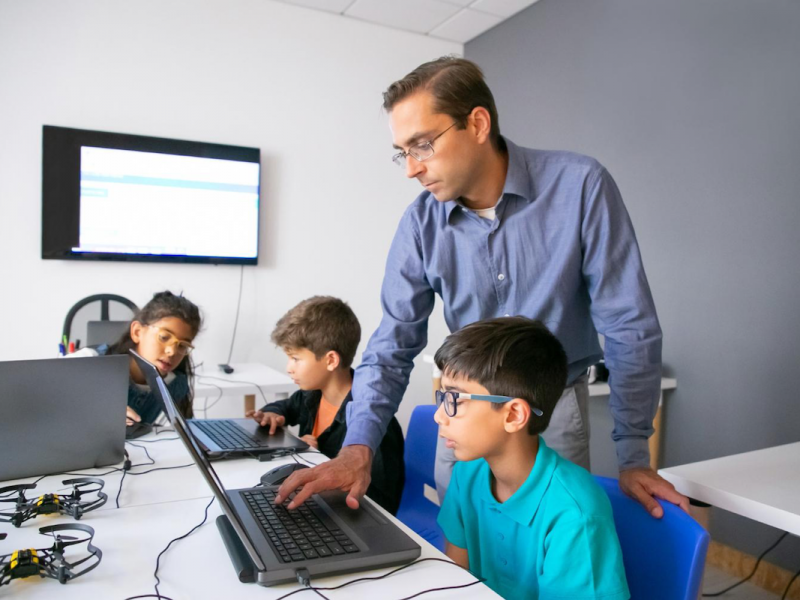In spite of the efforts, there has been a major disparity in access to online education, especially in the urban and rural areas, thanks to the digital divide that has now been laid bare because of COVID, writes Ashish Chaturvedi, founder, School Diary and uFony.
The pandemic has accelerated digital adoption across sectors, including education, which has witnessed one of the fastest disruptions in the teaching, assisted learning and VR space. From virtual classrooms, online assessments, smart learning tools and continuous learning options for professionals to skill upgradation, hobby classes, online fee payments for schools, AI powered edutainment solutions and parent-teacher engagement, technology solutions for the education sector have evolved manifold! Especially during times of COVID, when physical classrooms have shut, technology solutions adopted by schools are ensuring education is uninterrupted, by using various online learning tools. However, in spite of the efforts, there has been a major disparity in access to online education, especially in the urban and rural areas, thanks to the digital divide that has now been laid bare because of COVID.
The primary reasons for lack of access to online education due to the socio-economic standing of the parents or as part of the collective infrastructure challenge, include:
Unstable internet connectivity: Though we are among some of the largest consumers of smartphones, as a country, and the second largest in terms of internet penetration, the consistency of a strong broadband connection remains one of the main reasons for lack of access to online learning. While there are already talks about a 5G network set up, the existing 4G and lower bandwidth connectivity continues to remain disturbed or inconsistent.https://timesofindia.indiatimes.com/bennettjul2020_form_edutimes.cms
Lack of access to a device: Although smartphones remain popular, and can be useful when accessing online education, it is not always easily available for the children/entire family. In most cases, it is the father or both parents with a smartphone, who may or may not be able to regularly spare it for the children. They may also lack a common computer, like a desktop or laptop, for the house, making access to online learning a challenge for the children.
Unstable electricity connection and a strong wi-fi network: Although access to internet and a valid device remain a challenge, one of the key drawbacks to digital learning is often lack of basics like stable electricity connection and a strong wi-fi network. Not only charging but most town/rural homes lack power backup (inverter/genset), and power cut usually happens in late mornings/afternoons in residential areas to provide supply to local industries and hence the most important period for classes is spent without stable power.
Language barrier: Even as we work towards making the internet inclusive and accessible, the language as a mode of learning, remains a significant problem. As most content available on the web is in English, or to some extent, even in Hindi, other vernacular languages that form a major medium for learning across various parts of the country are yet to make their presence felt in the digital space.
Lack of trust in digital learning: While digital/online learning is looked upon as an advanced feature, it still remains an additional tool to support classroom learning. In the absence of traditional teacher-student interaction, most parents feel online learning is not complete enough and lacks the ‘discipline’ brought about by the presence of a teacher. Additionally, parents also fear the access to vast non-learning and leisure information the child can have, when left to online learning methods, in an unsupervised environment. While parents would require to monitor and assist children during online classes, they cannot devote 100% time to the same. From watching YouTube videos and games to surfing websites (even with the child lock/child supervision on), can not only be a massive waste of time but also expose children to content not meant to be consumed.
Not so tech friendly parents and teachers: A lot of parents and teachers are themselves not at the stage of being well versed with new-age apps. Especially in the rural or backward areas, the use of smartphones has been limited to entertainment, news, and communications. However, with digital learning, a lot of teachers are faced with the challenge to master the technology. Simultaneously, parents are also faced with the task of being better accustomed to technology and to learn the ropes so as to be able to teach/supervise their child to gain from online learning – a task not many parents are up for.
While there has been a lot of government interest and support in digitizing education with policies like ‘Digital India’ that are helping create better access, the National Education Policy 2020 that has made ‘digital learning’ an important part of education, and the ‘Digital up-skilling of India’, the onus continues to remain with schools. Schools and higher educational institutes need to work with parents and teachers, and upgrade and customize online learning for their students. This can be done through:
Cheaper/ discounted data packs: Schools in the rural or backward areas can help economising data for deserving students, and providing them free or subsidised data packs for accessing education apps/content/websites.
Customized solutions: Indian education system currently operates multiple boards like CBSE, ICSE, IB and the local state boards. The curriculum and content and teaching styles etc., varies drastically. Customization is the key for schools looking to create an integrated virtual learning experience for their students. Several ed-tech startups are working closely with educational institutes to customize solutions that would meet the need of their teachers and students, while ensuring cost-effective technology investments. Additionally, curating content in vernacular language is also an important part of customizing education to suite the parents and children coming from varied socio-economical background.
Training of teachers: Ensuring teachers are at ease with the new format of digital classrooms, is extremely important to make virtual classrooms a success. A shift from the chalk and board, presentational style teaching to a virtual or recorded teaching method is as difficult to adopt for teachers as it is for students. Adequate training and guidance for teachers can help them ease into the technology domain of teaching and can translate into effective learning for children.
Investing in technology infrastructure: A functional and effective technology infrastructure is vital for schools or any educational institute to ensure the tools and training can be effectively leveraged. The best of ed-tech solutions can be rendered ineffective with the basic infrastructure like a strong broadband connection and relevant devices needed to host a virtual classroom
Technology solutions beyond learning tools: When one speaks of ed-tech, the most common understanding is that it is limited to learning technology. However, a lot of schools/educational institutes are waking up to the benefit of ‘digitization’ of school operations and administration tasks. From tools like Live streaming of a physical classroom for the benefit of students who are unable to attend in person, to offering facial recognition technology for attendance, installing CCTV cameras in class and school premises to monitor social distancing norms, using enhanced CRM and communication tools for engaging with parents etc., can go a long way in ensuring a smooth, flawless and productive operations in schools. It also helps to take the load off the shoulders of teachers, who can then focus on their core qualities and not be bogged down by the additional tasks.
Even as most students, parents and schools are coming to terms with the realities of virtual learning, ed-tech solution providers are working tirelessly to create a more inclusive and adaptable digital learning ecosystem. In the post COVID era, much like in other sectors, education also will continue to integrate these new technology innovations for a seamless and effective education system. It is thus imperative for schools and educational institutions to work towards accelerated adoption of these solutions, so as to bridge the digital divide.
This article was first published in ‘TOI – Education Times’ on Oct 12, 2020


